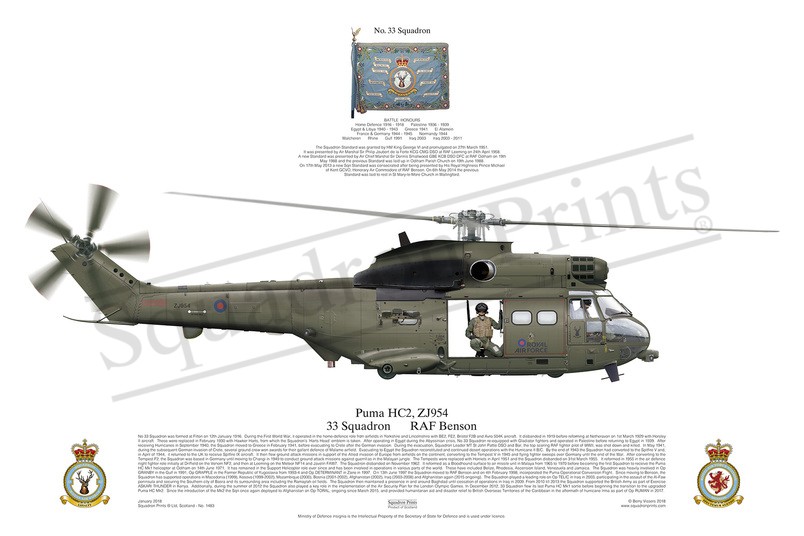#1483 Puma HC2

Purchased products will not feature the Squadron Prints watermark
Description
Squadron Prints Lithograph No. 1483 - Puma HC2, ZJ954, 33 Squadron, RAF Benson.
No 33 Squadron was formed at Filton on 12th January 1916. During the First World War, it operated in the home-defence role from airfields in Yorkshire and Lincolnshire with BE2, FE2, Bristol F2B and Avro 504K aircraft. It disbanded in 1919 before reforming at Netheravon on 1st March 1929 with Horsley II aircraft. These were replaced in February 1930 with Hawker Harts, from which the Squadron’s ‘Harts Head’ emblem is taken. After operating in Egypt during the Abyssinian crisis, No 33 Squadron re-equipped with Gladiator fighters and operated in Palestine before returning to Egypt in 1939. After receiving Hurricanes in September 1940, the Squadron moved to Greece in February 1941, before evacuating to Crete after the German invasion. During the evacuation, Squadron Leader MT St John Pattle DSO and Bar, the top scoring RAF fighter pilot of WWII, was shot down and killed. In May 1941, during the subsequent German invasion of Crete, several ground crew won awards for their gallant defence of Malame airfield. Evacuating to Egypt the Squadron reconstituted and continued desert operations with the Hurricane II B/C. By the end of 1943 the Squadron had converted to the Spitfire V and, in April of 1944, it returned to the UK to receive Spitfire IX aircraft. It then flew ground attack missions in support of the Allied invasion of Europe from airfields on the continent, converting to the Tempest V in 1945 and flying fighter sweeps over Germany until the end of the War. After converting to the Tempest F2, the Squadron was based in Germany until moving to Changi in 1949 to conduct ground attack missions against guerrillas in the Malayan jungle. The Tempests were replaced with Hornets in April 1951 and the Squadron disbanded on 31st March 1955. It reformed in 1955 in the air defence night fighter role initially at Driffield on the Venom NF2, and then at Leeming on the Meteor NF14 and Javelin FAW7. The Squadron disbanded on November 1962. It reformed as a Bloodhound surface to air missile unit in Malaya from 1965 to 1970 before becoming the first Squadron to receive the Puma HC Mk1 helicopter at Odiham on 14th June 1971. It has remained in the Support Helicopter role ever since and has been involved in operations in various parts of the world. These have included Belize, Rhodesia, Ascension Island, Venezuela and Jamaica. The Squadron was heavily involved in Op GRANBY in the Gulf in 1991, Op GRAPPLE in the Former Republic of Yugoslavia from 1993-4 and Op DETERMINANT in Zaire in 1997. On 13th June 1997 the Squadron moved to RAF Benson and on 4th February 1998, incorporated the Puma Operational Conversion Flight. Since moving to Benson, the Squadron has supported operations in Macedonia (1999), Kosovo (1999-2002), Mozambique (2000), Bosnia (2001-2002), Afghanistan (2002), Iraq (2003-2008) and Afghanistan again (2015 ongoing). The Squadron played a leading role on Op TELIC in Iraq in 2003, participating in the assault of the Al-Faw peninsula and securing the Southern city of Basra and its surrounding area including the Ramaylah oil fields. The Squadron then maintained a presence in and around Baghdad until cessation of operations in Iraq in 2009. From 2010 till 2013 the Squadron supported the British Army as part of Exercise ASKARI THUNDER in Kenya. Additionally, during the summer of 2012 the Squadron also played a key role in the implementation of the Air Security Plan for the London Olympic Games. In December 2012, 33 Squadron flew its last Puma HC Mk1 sortie before beginning the transition to the upgraded Puma HC Mk2. Since the introduction of the Mk2 the Sqn once again deployed to Afghanistan on Op TORAL, ongoing since March 2015, and provided humanitarian aid and disaster relief to British Overseas Territories of the Caribbean in the aftermath of hurricane Irma as part of Op RUMAN in 2017.
You may also like
-
Sentinel R1, Rivet Joint, Reaper, Shadow R1, Sentry AEW1
ZZ201; ZZ416; ZH103; ZJ694; ZZ6655 Sqn; 54 Sqn; 8 Sqn; 51 Sqn; 39 Sqn; 13 SqnRAF Waddington
